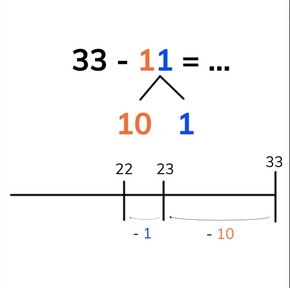8,000 schools use Gynzy
92,000 teachers use Gynzy
1,600,000 students use Gynzy
General
Students learn to subtract numbers to 100 by tens and ones.
Common core standard(s)
2.NBT.B.5
2.OA.A.1
Relevance
Discuss with students that they can use subtraction by tens and ones to solve math problems that they can't solve in one step in their heads. For example, if you want to know how many bikes are left at school if there were 76 and you take away 25.
Introduction
Divide the class into groups. Everyone in the groups takes turns counting from the starting number given on the interactive whiteboard to the final number given on the interactive whiteboard. When all students in the group have counted from the start to the end number, the group must stand up. The group that stands first is the winner. Repeat this game with different start and end numbers. Next ask students to name a number beween 50 and 100. Using a number line, students must jump to the given number. Ask students to share what kind of jumps they made to reach the given number and discuss that some jumps might be more useful than others.
Development
Explain to students that subtracting by tens and ones means splitting the second number in a subtraction problem (the subtrahend) into tens and ones and subtracting them separately from the first number in the subtraction problem (the minuend). Remind students that tens are a group of ten and that ones are the numbers 1 to 0. Explain that you can also solve a subtraction problem by tens and ones on the number line. Place the first number (the minuend) on the right side of the number line. Then determine which jumps are needed to take away the second number (the subtrahend) from the first (the minuend). Show the number line with a few jumps. Ask students which number has been jumped to on the number line. Together with students, practice another problem in which you take away tens and ones. Next tell students that you can also subtract by tens and ones without using a number line. You start by splitting the second number in the subtraction problem (the subtrahend) into tens and ones. You subtract the tens first, and then subtract the ones from that difference. Ask students to explain the steps taken to subtract by tens and ones. Have students solve a few problems subtracting by tens and ones and ask them to explain their strategy. Erase the grey boxes to check their work.
Check that students are able to subtract numbers to 100 by tens and ones by asking the following questions/giving the following problems:
- How do you subtract by tens and ones?
- What steps do you take to subtract by tens and ones?
- Solve the following: 73 - 12- ? and 45 - 35 = ?
Guided practice
Students start by solving subtraction problems with the support of a number line. They then are given the subtraction problems without a number line. Students are asked to complete the subtraction problem of the tens, ones as well as give the difference.
Closing
Discuss with students that it is important to be able to subtract numbers to 100 by tens and ones so you can easily solve problems with difficult numbers. Ask a student to come to the front of the class and show them a subtraction problem. The student must then solve the problem on the interactive whiteboard on the number line by drawing the jumps back to the show the difference. When the student has drawn the jumps on the number line, the class must determine the subtraction problem the number line represents and what the difference is. Next show a few subtraction problems. Ask the class to determine which subtraction steps belong to each subtraction problem as shown in the balloons. Drag the balloons to the correct place. Then have students find the difference.
Teaching tips
Students who have difficulty subtracting by tens and ones can make use of the number line. Emphasize to students that when subtracting by tens and ones that they first take away the tens, and then take away the ones from the resulting difference.
The online teaching platform for interactive whiteboards and displays in schools
Save time building lessons
Manage the classroom more efficiently
Increase student engagement
Discover more!
About Gynzy
Gynzy is an online teaching platform for interactive whiteboards and displays in schools.
With a focus on elementary education, Gynzy’s Whiteboard, digital tools, and activities make it easy for teachers to save time building lessons, increase student engagement, and make classroom management more efficient.







